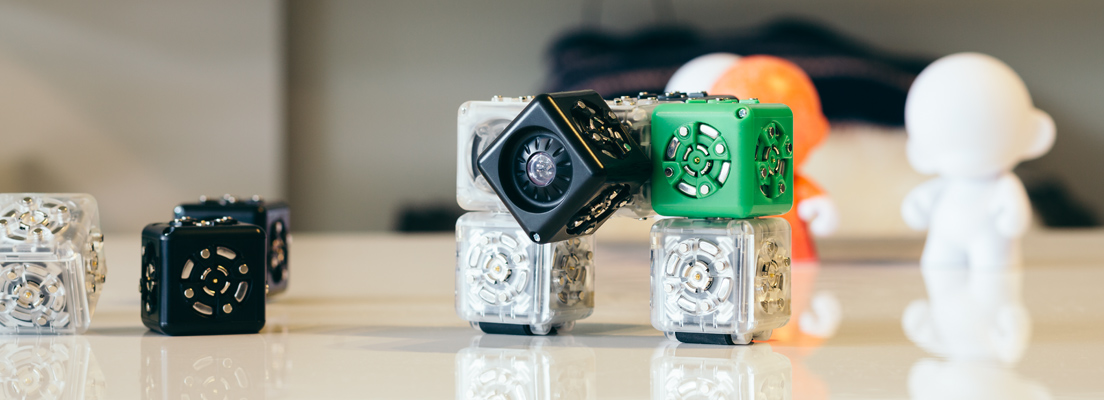A.B.6.5 | Building Different Robots

Created by: Modular Robotics
Lesson Overview:
Use this lesson as a review or an opportunity to strengthen skills for some, or all, of your students. In this lesson, students will be asked to build robots with designated capabilities. Students will be able to practice constructing robots, presented as puzzles, and will use the scientific method to build a robot accordingly.
The Basics:
Ages: 7-9 years (grades 1-3)Time: 30-45 minutes
Prep Time: 5 minutes
Lesson Goal (for the educator): Students will use their new knowledge to build robots with designated capabilities.
Lesson Objectives (for the students): My team will work together to build robots with certain capabilities.
Essential Questions: Why isn’t the robot working? What can we change to make the robot work?
21st Century Skills: Creativity and Innovation, Critical Thinking and Problem Solving, Communication and Collaboration
Concepts: Scientific process/inquiry, design process, testing, data collection, evaluating, rebuilding
Vocabulary: Aggressive, hypothesis, brainstorm, configuration, reconstruct
Required Cubelets: Distance, 2 Drive, Battery, Brightness, Flashlight, Rotate, Passive, Inverse, Blocker, Knob – enough for each group of 2-5 students
Additional Materials: Student Robot Journals
The Standards:
ISTE: International Society for Technology Education- Creativity and Innovation 1.b, 1.a, 1.c, 1.d
- Communication and Collaboration
- Critical Thinking, Problem Solving, and Decision Making 4.a, 4.b, 4.c, 4.d/li>
- Technology Operations and Concepts 6.a, 6.b, 6.c, 6.d
- ELA-Literacy.SL.1.1, 1.1.A, 1.1.B, 1.1.C, 1.4, 1.5
- ELA-Literacy.SL.2.1, 2.1.A, 2.1.B, 2.1.C, 2.4, 2.5
- ELA-Literacy.SL.3.1, 3.1.A, 3.1.B, 3.1.C, 3.1.D, 3.4, 3.5, W.3.10
Prior Knowledge Necessary for the Student:
A.B.5 | Data Collection and A.B.6 | Sensing and Magnitude, or equivalent experience with Cubelet behavior, the scientific method, and data collection.
Prior Knowledge for the Educator:
This is an opportunity for students to further investigate how to observe behavior and input when building robots. This is especially useful for students who need more practice with the concepts studied thus far.
Educator Tips:
Even if students find this easy, you can challenge them by asking them to customize the robot to fit a particular real-life problem they want to solve or to build their robots with 4 (or more) Cubelets rather than only 3 (or 4) Cubelets.
Preparation:
- Divide the class into groups of 2-5 students.
- For each group, place in a container the Cubelets they will need, along with a flashlight and a tent (see Educator Information Sheet).
Lesson:
Introduction:
-
Time: 2-3 Minutes
- “Today we are going to test your knowledge about Cubelets and building robots. Your team will have several challenges and you will be problem solving as a team. These challenges will help you practice building robots where the sense, think, and act Cubelets work together to make a robot. All of the challenges will be aimed at thinking about building something to meet a need, solve a problem, or make something that can help us do or understand something.”
- “Your team will be asked to build a robot. There are four challenges for you listed on this worksheet (A.M.4.5.WS), and a place for your team to sketch the robot you build.”
- “Work together and try to plan and build your robots. You don’t have to go in order, so we can certainly share the Cubelets if we need to.”
- “You will need to make a hypothesis, or prediction, about the configuration of the cubes you will need to put together in order to have the desired effect. Brainstorm ideas with your team and then test and retest your robot. You may need to reconstruct your robot several times to get it to work.”
Time to Explore:
-
Time: 15-20 Minutes
- Allow students to work in teams to solve the challenges.
- These are the four challenges listed on the worksheet:
- Make a robot that is “aggressive” and drives faster as it gets close to something.
- Make a robot that is “afraid” and drives away from things.
- Make a robot that is “confused” and drives in circles.
- Make a robot that lets you “use the force” to control it with your hand.
Time: 3-5 Minutes
- Stop the class and allow students to share their experiences. For each of the robots ask the students what problem, or need, the robot might be able to solve.
Closure/Evaluation:
-
Time: 5-7 Minutes
- Give students time to record in their Robot Journals. Encourage them to use words and other methods of recording such as charts, sketches, flow charts, etc. Time: 2-3 Minutes
- Allow time for students to put materials away and plug in the Battery Cubelets for recharging.
End Results:
Through the practice of solving problems and the design process, students will enhance their understanding of how to build robots that behave the way they want them to.
Optional Quick Writes For Prompt and/or Evaluation:
- What did you learn about when building robots today? Explain, using examples, and be sure to discuss important aspects of building with the Cubelets that you want to be sure to remember as we continue to build robots.
- What did you learn about working as a team? What is important? What kind of team player are you?
What To Go To Next:
For More Review:This work is licensed under a Creative Commons Attribution-ShareAlike 4.0 International License.


